Mitsubishi Triton
The Mitsubishi Triton is a compact pickup truck produced by Mitsubishi Motors. In Japan it was originally known as the Mitsubishi Forte[1] and from 1991 as the Strada. In the United States Chrysler Corporation sold captive imports as the Dodge Ram 50 and Plymouth Arrow truck, and Mitsubishi marketed it as the Mitsubishi Mighty Max until 1996.
| Mitsubishi Triton | |
|---|---|
_GLX_Double_Cab_utility_(2018-11-22).jpg) 2017 Mitsubishi Triton | |
| Overview | |
| Manufacturer | Mitsubishi Motors |
| Production | 1978–present |
| Body and chassis | |
| Class | Compact pickup truck |
| Layout | Front-engine, rear-wheel-drive or four-wheel-drive |
For most export markets the name L200 is used[2][3][4] though it also been known as the Rodeo,[5] Colt,[6] Storm, Magnum, L200 Strakar (badge used in Portugal since 1999, Strakar is a portmanteau of Strada and Dakar),[7] and others.
Cumulative sales of the first three generations exceeded 2.8 million units around the world.[8]
Currently the pickup truck is sold in every available Mitsubishi market except the United States, Bulgaria, Canada, Japan, India and China. In Japan, it was previously sold at a specific retail chain called Car Plaza.
In 2015, Fiat Professional launched a rebadged version as the Fiat Fullback. In 2016, Ram Trucks launched a rebadged version as the Ram 1200 for the Middle East market.
The Dodge Dakota-based Mitsubishi Raider is unrelated to the Mitsubishi Triton.
First generation (L020; 1978–1986)
| First generation (L020) | |
|---|---|
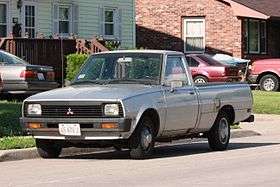 | |
| Overview | |
| Also called | Mitsubishi Forte Mitsubishi L200 Mitsubishi L200 Express (AU) Mitsubishi L200 Power X (TH) Mitsubishi Mighty Max (1982–1986) Chrysler D-50 (Australia) Chrysler L200 Express (Australia) Dodge D-50 (1979–1980) Dodge Ram 50 (1981–1986) Plymouth Arrow Truck (1979–1982) |
| Production | 1978–1986 |
| Model years | 1979–1986 |
| Assembly | Japan: Okazaki, Aichi (Nagoya Plant) |
| Body and chassis | |
| Body style | 2-door pickup |
| Powertrain | |
| Engine | 1.6 L 4G32/G32B I4 (gasoline) 2.0 L 4G52 I4 (gasoline) 2.0 L G63B I4 (gasoline) 2.6 L 4G54 I4 (gasoline) 2.3 L 4D55 I4-T (diesel) 2.5 L 4D56 I4 (diesel) |
| Transmission | 4-speed manual 5-speed KM132/KM145 manual |
| Dimensions | |
| Wheelbase | 2,780 mm (109.4 in) (SWB 2WD) 2,790 mm (110 in) (SWB 4WD) 3,035 mm (119.5 in) (LWB) |
| Length | 4,690 mm (184.6 in) |
| Width | 1,650 mm (65.0 in) |
| Height | 1,560–1,645 mm (61–65 in) |
The first generation model of Mitsubishi's compact pickup truck was first sold in Japan as the Mitsubishi Forte in 1978 and continued until late 1986, when the line was cancelled in the Japanese domestic market for five years. In Japan the Forte was originally sold with the 92 PS (68 kW) 1.6-liter 4G32 engine (L021P).[9] Later this was updated to the 86 PS (63 kW) 1.6-liter G32B engine with two-wheel drive (LO25) or with four-wheel drive coupled to the 2.0-liter Sirius G63B with 110 PS (81 kW) (L026). Offered in basic Deluxe trim, the larger-engined version was also available in leisure-oriented Custom trim.[10] The Custom also has a smoother and less utilitarian bed, without provisions for fitting a canvas top and with fewer hardpoints for strapping down loads.
.jpg)
_Commercial_utility_(16841296922).jpg)
_2.3_Diesel_4WD_utility_(22526560332).jpg)
_4WD_cab_chassis_(2015-06-03)_01.jpg)

In export versions, the 2.0-liter gasoline version had 93 hp (69 kW), while a larger 2.6-liter unit offered 105 hp (78 kW). Also popular in many markets, was a 67 PS (49 kW) 2.3-liter diesel engine. The 73 PS (54 kW) 1.6-liter Saturn engine rounded out the lineup in many countries.[11] A naked cab and chassis version was also available in some markets.
Mechanical features included recirculating ball steering and front disc brakes, rear-wheel drive, and front suspension with coil springs.[12][13] Four-wheel drive (4WD) was added in 1981,[14] featuring torsion bar suspension up front.[13] The rear suspension for both comprised leaf springs with bias-mounted shock absorbers.[12][13] The 4WD system incorporated an extra lever located alongside the main four-speed shifter.[14] This provided three positions; 2WD in high-range, 4WD in high-range, and 4WD in low-range. In low-range, the vehicle travels at half road speed for any given engine rpm.[14] The transfer case is chain-driven to the front wheels, making it lighter, quieter, and easier to shift than the more common gear type.[14] As such, the driver can shift between 2WD and 4WD in high-range without using the clutch, with the activation of low-range requiring the vehicle to be stopped.[14] A warning lamp would light when the 4WD was engaged.[14]
Chrysler variants
The Dodge Ram 50 (called the Dodge D-50 for 1979 and 1980) was a badge-engineered version sold by the Chrysler Corporation from 1979 on. The label lasted until 1994, through two generations of the truck. Plymouth also received a version of the truck known as the Plymouth Arrow truck, sold from 1979 to 1982. This was Chrysler's belated answer to the Ford Courier from Mazda and the Chevrolet LUV by Isuzu (both of which had been introduced in 1972). Mitsubishi itself imported it as the Mitsubishi Mighty Max when it began selling directly in the US from 1982, at which point the Plymouth ceased to be available. The Dodge version had quad rectangular headlights beginning with the 1983 facelift, while Mitsubishis and earlier Dodges had single units in North America. In the rest of the world, importers could choose between single or double rectangular units, as well as twin round headlights.[15] The twin round units were the original fitment for the Japanese domestic market.
Four-wheel drive was added for 1982. This created the Power Ram 50 in the United States, as in Dodge's nomenclature the "Power Ram" name was used for four wheel drive models. A turbo diesel engine was available in US models between 1983 and 1985. The 1983 turbodiesel was fitted with a TC05 non-wastegated turbo and produced 80 hp (60 kW) and 125 lb⋅ft (169 N⋅m) torque. The 1984–1985 turbodiesels were fitted with a TD04 wastegated turbo which resulted in 86 hp (64 kW) and 134 lb⋅ft (182 N⋅m) torque.
Chrysler Australia launched the first generation in April 1979 as the MA series Chrysler D-50.[12] Initially, two pickup versions were sold, the Commercial with the 1.6-liter Saturn (4G32) engine and the higher specification Recreational with the 2.0-liter Astron (4G52) engine.[12] Both Commercials and Recreationals received a floor-shifted 4-speed manual, with a taller axle ratio for the Recreational.[16] Commercials were specified with heavy duty suspension rated for 1,000-kilogram (2,200 lb) payloads; the Recreational version carries a 500-kilogram (1,100 lb) load.[12] The reason for the halved payload was due to the sedan-type suspension of softer springs and more supple shock absorbers.[16] The Recreational model also featured radial ply tires, electronic ignition, bucket seats, pile carpet, radio, floor console, sports steering wheel and an adjustable steering column as standard.[12] An optional sports stripe package was also available.[12] Options included a weather-tight, fibreglass canopy with foam rubber mattress.[16] This was manufactured by Challenge Industries and incorporated sliding side windows.[14] Later in 1979, a cab chassis body variant of the Commercial was released.[17][16] In March 1980, the D-50 was renamed Chrysler L200 Express to form linkage with the newly released L300 Express vans.[17] In October 1980, the Chrysler labelling made way for Mitsubishi badges following the establishment of Mitsubishi Motors Australia from Chrysler Australia's old operations.[18] In June 1981, Mitsubishi released 4WD versions of the pickup and cab chassis, both with the 2.0-liter motor.[19] Free-wheeling hubs to reduce noise and fuel use in 2WD mode were optional.[14] In late 1981, the 2.0-liter with five-speed manual was made optional for the 2WD one-tonne suspension models.[20]
Second generation (K00/K10/K20/K30;1986–1996)
| Second generation (K00/K10/K20/K30) | |
|---|---|
| Overview | |
| Also called | Dodge Ram 50 (1987–1994) Mitsubishi Triton (Australia) Mitsubishi Cyclone (Thailand) Mitsubishi Colt (South Africa) Mitsubishi L200 Mitsubishi Mighty Max Mitsubishi Strada |
| Production | 1986–1996 |
| Assembly |
|
| Body and chassis | |
| Body style | 2-door pickup 4-door pickup |
| Powertrain | |
| Engine | |
| Transmission | 4-speed automatic 5-speed manual |
| Dimensions | |
| Wheelbase | Short Bed: 2,680 mm (105.5 in) Long Bed/Ext. Cab: 2,950 mm (116.1 in) |
| Length | Short Bed: 177.2 in (4,501 mm) Long Bed/Ext. Cab: 193.7 in (4,920 mm) Ext. Cab: 188.2 in (4,780 mm) |
| Width | 1,655 mm (65.2 in) Mighty Max 4WD: 65.9 in (1,674 mm) Mighty Max Sport Cab 4WD: |
| Height | Short Bed: 58.5 in (1,486 mm) Long Bed/Ext. Cab: 59.3 in (1,506 mm) 1991–93 Ext. Cab: 59.7 in (1,516 mm) 1987–1990 Ext. Cab: 59.6 in (1,514 mm) 1991–93 Long Bed/Ext. Cab 4WD: 64.4 in (1,636 mm) 1989–1990: 58.3 in (1,481 mm) |
| Curb weight | 1,220–1,635 kg (2,690–3,605 lb)[21] |
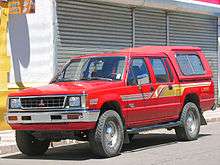
.jpg)
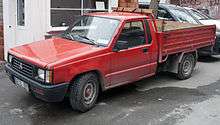

The second generation model was introduced in 1986 for most markets. In Australia, this model launched in October 1986 as the low-cost Triton. In Japan the pickups were not sold for a few years, making their return as the Strada in Japan in March 1991.[22] A facelift took place for the 1993 model year, with a new grille and new plastic bumpers comprising most of the changes.[23] It continued to be produced until 1996. Sales in the Japanese domestic market continued into the middle of 1997. The truck usually has a 68 hp (51 kW) 2.5 litre diesel or an 84 PS (62 kW) turbo diesel engine, with the turbo diesel being the only engine available in the Japanese home market. The Triton was not a spirited performer, with a four-wheel drive V6 model having a top speed of 126 km/h (78.1 mph). The second generation Mitsubishi truck was also produced in Thailand. In the US it was known as the Mitsubishi Mighty Max or the Dodge Ram 50. Petrol engines include a carburetted 92 hp (69 kW) 2.0 litre inline-four or a 2.6-litre ditto with 109 hp (81 kW). Four-wheel drive (non-LSD) was also available, as were different bed lengths and both extended and double cab options.
Starting out as a fairly utilitarian truck, more comfortable versions were gradually added in most markets. In New Zealand & Australia, a small, 3.0-litre, V6 engine with 90 kW (122 PS; 121 hp) was added in early 1993. The V6 was not a well liked engine specification by consumers, as it did not tow as well or make as much torque as the diesel four-cylinder engine did, and used much more fuel than the four-cylinder.The 3.0L V6 6G72 equipped models also had a flaw in the design of the engine lifters- noisy lifters resulted in catastrophic engine failure over time.[23] The locally developed L200 Sport range, more stylish and often featuring two-tone paint, was very popular in New Zealand where the L200 was offered with five different engines.[23]
Dodge Ram 50
The Ram 50 was redesigned for 1987, which was the same year Chrysler introduced the Ram 50's successor, the Dodge Dakota. Despite this, sales of the Ram 50 continued for another seven years until 1994, possibly because the Ram 50 was a compact and the Dakota was a mid-size. The difference in size and cost left a niche for the Dodge 50, and its cancellation may have been due more to a desire to show independence from Mitsubishi than because of any product overlap. The Mighty Max ended production after the 1996 model year, and its successor was not marketed in North America due to poor sales.
Third generation (K50/K60/K70; 1996–2006)
| Third generation (K50/K60/K70) | |
|---|---|
_GL_2-door_cab_chassis_(2015-08-07).jpg) | |
| Overview | |
| Also called | Mitsubishi Colt (South Africa) Mitsubishi Triton (Australia) Mitsubishi L200 Mitsubishi Storm Mitsubishi Strada (Japan, Thailand) Mitsubishi Magnum Mitsubishi Strakar (Portugal) |
| Production | 1996–2006 |
| Assembly | Japan: Aichi Brazil: Catalão Philippines: Cainta |
| Body and chassis | |
| Body style | 2-door pickup 4-door pickup 5-door wagon[24] |
| Related | Mitsubishi Pajero Sport (1st generation) |
| Powertrain | |
| Engine | |
| Transmission | 5-speed manual 4-speed automatic |
| Dimensions | |
| Wheelbase | 2,950 mm (116.1 in) |
| Length | 4,995 mm (196.7 in) |
| Width | 1,625 mm (64.0 in) |
| Height | 1,585–1,710 mm (62.4–67.3 in) |
| Curb weight | 1,295–1,700 kg (2,855–3,748 lb)[25] |
_GLX_4-door_utility_(2015-05-28)_02.jpg)


.jpg)
In 1996, a new generation model was introduced with 2.5-liter turbodiesel engines developing 103 hp (77 kW). Other engine options include two sixteen-valve fuel injected gasoline engines and a naturally aspirated diesel.[25] The previous 2.6-liter unit was replaced with a new, considerably more powerful 2.4-liter engine with 145 hp (108 kW).[25] The car participated in the Dakar Rally in 2005. Production ended in 2006. These were only built in Laem Chabang, Thailand, and were also exported to Japan between 1997 and 1999. In late 2001 the third generation pickup underwent a facelift with new headlights and other changes.
An SUV model developed from the Mitsubishi Triton, called the Mitsubishi Challenger was released to Japan in 1996. In overseas markets it was also badged Montero Sport, Pajero Sport, Shogun Sport, or Nativa. Challenger shares many components and some body panels (i.e. front doors) with the Strada pickup truck and utilises the second generation Mitsubishi Pajero wheelbase. The Challenger was also produced in Thailand as the Mitsubishi Strada G-Wagon.[24] The Thai model, unlike the same vehicle manufactured elsewhere used the same front styling as the Strada pickup truck that it was based upon. It was retired from production in 2005, but the Challenger nameplate was resurrected for the second generation of the Mitsubishi Pajero Sport, launched in 2008 and which is also based on the following generation of the Mitsubishi Triton.[24]
Fourth generation (KA/KB; 2005–2014)
| Fourth generation (KA/KB) | |
|---|---|
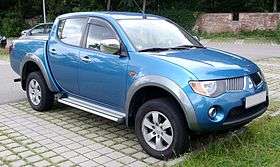 Mitsubishi L200 | |
| Overview | |
| Also called | Mitsubishi L200 Mitsubishi Triton (Australia/Japan/Thailand) Mitsubishi Strada (Philippines) Mitsubishi Strada Triton (Indonesia) Mitsubishi Sportero Mitsubishi Hunter (Israel) Mitsubishi Strakar (Portugal) |
| Production | 2005–2014 2005–present (Brazil) |
| Assembly | Thailand: Laem Chabang (Mitsubishi Thailand) Brazil: Catalão South Africa: East London (Daimler AG) |
| Body and chassis | |
| Body style | 2-door pickup 4-door pickup |
| Related | Mitsubishi Pajero Sport (KG/KH/PB) |
| Powertrain | |
| Engine | 2.4 L 4G64 I4 (gasoline) 2.4 L 4G64 I4 (Gasoline/CNG) (Triton CNG) 2.5 L 4D56 I4-T (diesel) 3.2 L 4M41 I4-T (diesel) 3.5 L 6G74 V6 (gasoline) |
| Transmission | 5-speed manual 4-speed automatic 5-speed automatic |
| Dimensions | |
| Wheelbase | 3,000 mm (118.1 in) |
| Length | 5,040 mm (198.4 in) FBB: 4,835 mm (190.4 in) Crew Cab: 5,115 mm (201.4 in) |
| Width | 1,750 mm (68.9 in) Crew Cab: 1,800 mm (70.9 in) |
| Height | 1,655 mm (65.2 in) Crew Cab: 1,775 mm (69.9 in) 4x4: 1,780 mm (70.1 in) |
_GL-R_4-door_utility_02.jpg)
_GL_cab_chassis_(2015-07-03).jpg)
The fourth generation Triton was released in 2005. Designed by Akinori Nakanishi, it is built exclusively by Mitsubishi's subsidiary in Thailand and is exported to 140 global markets.[3] It is mostly known as L200 except for Japan and its subsidiary countries' markets. The car has a 2.5-liter turbodiesel engine developing 134 kW (180 hp). The base version, available in some markets such as the Dominican Republic, has a 2.5-liter normally aspirated diesel engine and the L200 off-road version called the Savana has 200 hp.
In Japan, the Triton was exclusively equipped with 3.5-litre petrol engine and 4-speed automatic transmission and was sold from 2006 to 2011 - the only pick-up truck in the market at that time (excluding kei trucks). Despite its success overseas, it was a critical failure in Japan as workmen and traders preferred vans and station wagons. As a result, in August 2011 the Triton was pulled out from Mitsubishi's Japanese lineup.[26]
Fifth generation (KJ/KK/KL; 2015–present)
| Fifth generation (KJ/KK/KL) | |
|---|---|
 Mitsubishi L200 Barbarian (Pre-facelift) | |
| Overview | |
| Also called | Mitsubishi L200 Mitsubishi Triton Fiat Fullback Ram 1200 Mitsubishi Strada Mitsubishi Strakar (Portugal) Mitsubishi Barbarian (Europe) |
| Production | 2015–present |
| Assembly | Thailand: Laem Chabang (Mitsubishi Thailand) Brazil: Catalão |
| Body and chassis | |
| Body style | 2-door pickup 4-door pickup |
| Related | Mitsubishi Pajero Sport (KR/KS/QE) |
| Powertrain | |
| Engine | 2.4 L 4G64 I4 (gasoline) 2.2 L 4N14 TD I4 (Export) 2.4 L 4N15 MIVEC I4-T (diesel) 2.5 L 4D56 I4-T (diesel) |
| Transmission | 6-speed manual 5-speed manual 5-speed automatic 6-speed AISIN R6AWH / V6AWH automatic |
| Dimensions | |
| Wheelbase | 3,000 mm (118.1 in) |
| Length | 5,210 mm (205.1 in) |
| Width | 1,820 mm (71.7 in) |
| Height | 1,780 mm (70.1 in) |
_04.jpg)
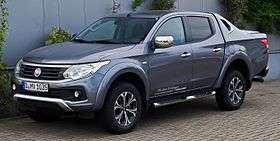
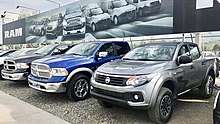
In 2014, Mitsubishi unveiled the all new L200 which went on sale in early 2015 (Asia Pacific) and late 2015 (Europe and the Caribbean). It is powered by a new 2.4-litre diesel engine. Since 2015, the current generation L200 shares the same underpinnings as the newly rebadged Fiat Fullback intended for the European and Middle East markets.[27] Fiat Chrysler Automobiles currently has no plans to introduce the Fullback in the North American market due to the U.S. chicken tax as well as the introduction of the Jeep Gladiator, based on the fourth-generation Jeep Wrangler SUV.[28][29][30] For the 2017 model year, Ram Trucks rebadged the Triton as the Ram 1200 for the Middle East market.[31]
In addition, due to being plagued by the previous-generation Triton's critical failure in Japanese market (in contrast to its overseas success), in addition to having heavy excise duties for pickup trucks there, Mitsubishi Motors currently has no plans to bring the current Triton to their home market.
Malaysia
The fifth generation Mitsubishi Triton was launched in Malaysia in May 2015 as the Mitsubishi Triton being fully imported from Thailand. It was available in five variants: Triton Quest (MT), Triton MT, Triton VGT MT, Triton VGT AT and Triton VGT Adventure (AT). The VGT models came with a 2.5L variable geometry turbo engine capable of producing 178 PS and 400 Nm. The Triton MT had a 2.5L commonrail turbo engine capable of producing 136 PS and 324 Nm and the Triton Quest had a 2.5L DOHC commonrail engine with 110 PS and 200 Nm.[32][33][34][35][36] Two limited editions were made available including the: Triton Phantom Edition in January 2016[37] and the Triton Knight Edition in May 2016.[38] Both were limited to 200 units each. In September 2016, alongside of the change of engine for the VGT models to a 2.4L MIVEC VGT turbodiesel engine capable of 181 PS and 430 Nm, the Triton VGT Adventure X was also launched as the new range topper.[39] In April 2017, the Triton was updated. Changes included additional safety features for the VGT models, change in the steering wheel design and different colour choices.[40] In September 2017, the Triton VGT AT GL was launched and was positioned in between the Triton MT and Trition VGT MT.[41] In November 2017, the Triton VGT AT Premium was launched.[42] In January 2018, the Triton Athlete was launched as the new range topper.[43]
In January 2019, the facelifted fifth generation Triton was launched in Malaysia with five variants: VGT (MT and AT), VGT Premium (MT and AT), Adventure X (AT only). The 4x2 Quest model remained unchanged.[44]
2019 facelift

.jpg)
The Triton was refreshed for the 2019 model year at the 2018 Thailand International Motor Expo in Bangkok, Thailand. This update consists of new front fascia, which is inspired from the Pajero/Montero Sport, Eclipse Cross and Xpander,[45] new teardrop taillight design treatment as the Pajero/Montero Sport, and slight changes in the interior for some variants. This model also received a rear air circulator located at the interior roof.[46][47]
Sales
| Calendar Year | Thailand |
|---|---|
| 2014 | 33,105[48] |
| 2015 | 25,261[49] |
| 2016 | 23,584[50] |
| 2017 | 32,450[51] |
| 2018 | 39,984[52] |
| 2019 | 35,789[53] |
References
- Edsall, Larry. "Mitsubishi Pickup celebrates 40th birthday". The ClassicCars.com Journal. Retrieved 21 November 2018.
- "Mitsubishi Forte" Archived 2007-09-28 at the Wayback Machine, Mitsubishi Motors South Africa website
- "Mitsubishi Motors releases new Triton pickup truck in Thailand", Mitsubishi Motors press release, 25 August 2005
- "Mitsubishi Motors launches Triton urban sports pickup", Mitsubishi Motors press release, 21 September 2006
- "2006 Mitsubishi bakkie range" Archived 2007-11-06 at the Wayback Machine, Mitsubishi Motors South Africa website
- "Price drop, new look for Colt bakkie: : New Models". Wheels24.co.za. Retrieved 16 July 2010.
- http://www.mitsubishi-motors.pt/explores.aspx?id=9374#/Intro Archived 2011-04-04 at the Wayback Machine Mitsubishi Motors Portugal – L200 Strakar
- "Triton" Archived 2007-09-29 at the Wayback Machine, Technology Review 2006, no.18, pp.144–147, Mitsubishi Motors website
- "自動車ガイドブック [Japanese Motor Vehicles Guide Book]" (in Japanese). 25. Japan: Japan Automobile Manufacturers Association. 10 October 1978: 223. 0053-780025-3400. Cite journal requires
|journal=(help) - Forte 1 ton bonnet truck (brochure) (in Japanese), Tokyo, Japan: Mitsubishi Motors Corporation, December 1982, p. 12, 01.29.01(82–12)
- Mitsubishi L200 (brochure), Tokyo, Japan: Mitsubishi Motors Corporation, October 1983, p. 16, OC01'(10)
- "Chrysler moves into light truck market". The Canberra Times. 24 April 1979. p. 18. Retrieved 12 September 2016.
- "Mitsubishi Express 'is the answer'". Victor Harbour Times. 7 June 1985. p. 17. Retrieved 12 September 2016.
- Davis, Pedr (3 November 1981). "Mitsubishi's 4WD entry is no amateur". The Canberra Times. p. 10. Retrieved 12 September 2016.
- Mitsubishi L200 (brochure), p. 15.
- Davis, Pedr (8 July 1980). "Sedan comfort combined with utility's room and versatility". The Canberra Times. p. 19. Retrieved 12 September 2016.
- "New vehicles from Chrysler". Victor Harbour Times. 2 April 1980. p. 14. Retrieved 12 September 2016.
- Davis, Tony (11 March 1994). "Diamonds Are For Export". The Sydney Morning Herald. Archived from the original on 10 May 2015.
- "New economical, rugged 4 WD". Victor Harbour Times. 3 June 1981. p. 10. Retrieved 12 September 2016.
- Gover, Paul (24 November 1981). "Mitsubishi Express steals a march on competitors". The Canberra Times. p. 10. Retrieved 12 September 2016.
- Mitsubishi Motors: Commercial Vehicle Range (brochure), Cirencester, Glos., UK: The Colt Car Company, 1989, pp. 12–13
- イラスト カタログ:ストラーダ [Illustrated catalog: Strada] (parts catalog) (in Japanese), Mitsubishi Motors Corporation, September 1996, p. A2, A0330707K1
- Anderson, Donn (March 1993). "Commercials". New Zealand Car. Vol. 7 no. 5. Auckland: Accent Publishing. pp. 80–81. ISSN 0113-0196.
- "Mitsubishi Pajero Sport – Return of the G-Wagon". bkkAutos.com. 18 July 2008. Retrieved 14 August 2016.
- "L200 – Specifications". Bahrain: Mitsubishi Motors. 2003. Archived from the original on 26 August 2012. Retrieved 14 August 2016.
- "【ニュース】三菱、「トライトン」/「L200」の新型を11月9日に初公開!" [News: Mitsubishi to unveil new Triton (L200) on November 9th!]. Web Motor Magazine (in Japanese). Motor Magazine Co., Ltd. 2018-10-16. Archived from the original on 2019-12-08.
- "2015 Mitsubishi L200 unveiled".
- Strong, Michael. "Fiat Ready to Ground and Pound with New Fullback". The Detroit Bureau. Retrieved 20 January 2016.
- Halvorson, Bengt. "Jeep Wrangler Pickup Confirmed: Future Rival To The Ford Ranger?". The Car Connection. Retrieved 20 January 2016.
- Kirchner, Chad. "2020 Jeep Gladiator Pickup Truck: Everything You Need to Know, and Then Some". The Drive. Retrieved 2 May 2019.
- Fink, Greg. "Raider of the Rebadge: Ram 1200 Is a Mitsubishi Pickup for the Middle East". Car and Driver. Retrieved 24 November 2016.
- "2015 Mitsubishi Triton launched in Malaysia - fr RM67k". Paul Tan's Automotive News. 2015-05-26. Retrieved 2018-03-25.
- "All-new Mitsubishi Triton launched in Malaysia | Motor Trader Car News". Motor Trader Car News. 2015-05-26. Retrieved 2018-03-25.
- "All-New 2015 Mitsubishi Triton Launched In Malaysia: From RM70k to RM112k - Buying Guide - Carlist.my". www.carlist.my. Retrieved 2018-03-25.
- "Mitsubishi Motors Malaysia - News & Events". mitsubishi-motors.com.my. Retrieved 2018-03-25.
- "2015 Mitsubishi Triton launched in Malaysia, priced from RM67k to RM108k [+Video] - AutoBuzz.my". AutoBuzz.my. 2015-05-26. Retrieved 2018-03-25.
- "Mitsubishi Triton Phantom Edition launched in Malaysia". Paul Tan's Automotive News. 2016-01-07. Retrieved 2018-03-25.
- "Mitsubishi Triton Knight Edition - 120 units, RM122k". Paul Tan's Automotive News. 2016-05-17. Retrieved 2018-03-25.
- "Mitsubishi Triton VGT upgraded - now with 181 PS, 430 Nm 2.4L MIVEC diesel engine, new X variant". Paul Tan's Automotive News. 2016-09-05. Retrieved 2018-03-25.
- "2017 Mitsubishi Triton receives ESP, seven airbags and five-year/200,000 km warranty - RM77k-RM131k". Paul Tan's Automotive News. 2017-04-07. Retrieved 2018-03-25.
- "Mitsubishi Triton VGT AT GL Introduced - Performance Without Excess - Auto News - Carlist.my". www.carlist.my. Retrieved 2018-03-25.
- "Mitsubishi Triton VGT Premium Launched; 2.4 MIVEC Diesel, RM116k - Auto News - Carlist.my". www.carlist.my. Retrieved 2018-03-25.
- "Mitsubishi Triton Athlete lands in Malaysia - RM127k". Paul Tan's Automotive News. 2018-01-17. Retrieved 2018-03-25.
- "2019 Mitsubishi Triton launched - Dynamic Shield face, 2.4L MIVEC and 6-speed for all, from RM100k". Paul Tan's Automotive News. 2019-01-30. Retrieved 2019-01-30.
- "2019 Mitsubishi Strada facelift to get Montero Sport-style redesign". AutoIndustiya.com. 2018-10-17. Retrieved 2018-10-17.
- "What do you think of the 2019 Mitsubishi Strada's tail lights? - Auto Industry News". AutoIndustriya.com. 2018-10-19. Retrieved 2018-10-21.
- "2019 Mitsubishi Triton facelift debuts in Thailand – updated design, new six-speed auto, improved safety". Matthew H. Tong. 2018-11-09. Retrieved 2018-11-09.
- "Malaysia cars sales report 2014". HeadlightMag.com. Thailand. Retrieved 24 Oct 2018.
- "Malaysia cars sales report 2015". HeadlightMag.com. Thailand. Retrieved 24 Oct 2018.
- "Malaysia cars sales report 2016". HeadlightMag.com. Malaysia. Retrieved 24 Oct 2018.
- "Malaysia cars sales report 2017". HeadlightMag.com. Malaysia. Retrieved 24 Oct 2018.
- "Thailand pick-up sales report 2018". HeadlightMag.com (in Thai). Thailand. Retrieved 22 Jan 2019.
- "Thailand pick-up sales report 2019". HeadlightMag.com (in Thai). Thailand. Retrieved 25 Feb 2020.
External links

- Mitsubishi Triton official website (in Japanese)